What is all this controversy about work contracts and young people's jobs in France? As far as I understand, it is very difficult in France to fire an unproductive or uncooperative worker. That makes employers extremely cautious in their hiring practices. They want to make sure they have found the right person for the job before they hire anybody. Unemployment among the young is very high -- 10 to 20 per cent.
Add to this situation the reluctance of employers to hire people who are not ethnically French. Unfortunately, racism exists, in France as in other countries. There is a generation of 20-somethings in France who have been born here to parents that immigrated from, for example, North Africa (Algeria, Tunisia, Morocco) and black Africa (Mali, Sénégal, Côte d'Ivoire, etc.) back in the 1970s and '80s. These are the young people who rioted in the Paris suburbs last year. Many of them are unemployed, bored, and angry.
President Jacques Chirac's prime minister, Dominique de Villepin, has come up with and, despite strong opposition, succeeded in pushing through the French National Assembly (the parliament) a law decreeing that employers can hire workers younger than 26 years old under a contract imposing a two-year probationary period. At any time during those two years, the young employee can be let go without cause.
Understandably, a lot of people see this scheme as setting up a situation in which young people can be exploited for two years at low wages. Then the employers can let them go and hire other young people, at similarly low wages, instead of putting the more experienced young employees on long-term contracts at a higher pay rate. From this perspective, the government's new employment contract (the CPE, or Contrat Première Embauche) is fundamentally unfair to young workers. It institutionalizes a system in which they have little or no job security.
(All this reminds me of the tenure system in American universities, which was much abused in the same way back in the late 1970s and early 1980s. There were too many tenured professors and too many new PhDs looking for work, so a lot of young professors were denied tenure despite their excellent job performance. It's one of the reasons I got out of teaching back then.)
Why would the Chirac government want to set up such a system? The only thing that makes sense to me is that Chirac and Villepin understand that employers are reluctant to hire young workers in general, and young people who are not ethnically French specifically. If an employer has an escape clause -- the two-year probationary period -- maybe more of these French-born children of African and North African immigrants will find jobs. There will be less anger in the projects (
les cités) surrounding the big cities. But even if this is true, it is unspoken and perhaps unspeakable in France, for all kinds of philosophical and political reasons.
It is clear that French employers, the government, and French people in general are opposed to American-style "affirmative action" programs. Here, what Americans call affirmative action is called
discrimination positive. The point is that it is viewed as a form of discrimination. France is a country with a long history of social inequality because of the centuries-long existence of a class of aristocrats that ruled the country and were inherently "better" than their compatriots. They had distinct privileges. Officially, that social system ended in the 1790s with the French Revolution. With the institution of the republic in the 19th and 20th centuries, the ideal became
égalité -- equality. All people are equal.
But while the U.S. has its long history of slavery that turned into nominally free if under-privileged class of African-American citizens, the existence in France of a significant population of ethnically different people is a relatively new reality. The situations are very different, and maybe very different solutions to the resulting tensions in the society are called for.
There is also significant opposition in France to the American model of what the French call
communautarisme -- ethnic, religious, and social communities within the society. All people are equal, theoretically, and there is no need for society to divide itself into interest groups on the basis of gender, sexual orientation, ethnicity, or religious beliefs. Affirmative action programs would be a tacit acknowledgment that such communities already exist in France.
When you apply for a job in France, you are expected to attach a photo to your resumé. That's a practice that was banned in the U.S. many years ago. The picture makes it too easy for employers to eliminate people whom they want, for reasons of ethnicity, to screen out. It aids and encourages negative racial discrimination, and makes it harder for minority candidates to get a foot in the door.
After last fall's riots in the housing projects and new towns that surround Paris, there was a proposal to move to a system of "anonymous" resumés in France. Candidates would no longer have to include a photo, and they wouldn't even have to give their name (because the name might not sound French) or their address (because if you live in certain housing projects, there's a good chance that you are not ethnically French). This was to be an experiment, a pilot program. It occurs to me that measures such as these are proof that ethnic communities really do exist in France, but let's not get sidetracked. French people are entitled to a little denial, I guess.
So maybe the CPE is a kind of affirmative action plan in disguise. Sooner or later, I think, somebody in France is going to have to point out that the emperor has no clothes. Communities exist. Racism exists. The integration model is not working -- young people of foreign descent are not accepted as full-fledged members of French society. They are different (we Americans talk of the benefits of diversity) but in this case
Vive la différence! doesn't apply. What's the point of denying that?
Meanwhile, many students, whether they are fully French or not, are participating in demonstrations against the Villepin youth employment plan. That's the way politics works in France, at the national level. The government, the out-of-power political parties, the students, and the labor unions are competing power blocks, and they use shows of force and numbers as necessary and as much as they can to move policy in the direction they favor.
But now something has changed. Groups of angry non-students (it is assumed) are taking advantage of the student demonstrations and unrest to wreak havoc and destruction in the cities. There's a level of violence that didn't exist before.
Tomorrow a nationwide general strike is planned. The trains won't run and there will be little if any public transit in Paris and other cities. Schools will be disrupted. There will be major marches and demonstrations, especially in university towns and large cities around the country. The question is, will there be a lot of violence? Will the demonstrations turn into riots? Stay tuned.




 Lettering on a piece of gardening equipment at the château de Chaumont-
Lettering on a piece of gardening equipment at the château de Chaumont- Fresh fruit on sale at the Saint-Aignan market. Apples are plentiful right now.
Fresh fruit on sale at the Saint-Aignan market. Apples are plentiful right now. Above, a display at the farmers' market in Saint-Aignan. Below, cheeses in the window of a shop in the town of Selles-sur-Cher.
Above, a display at the farmers' market in Saint-Aignan. Below, cheeses in the window of a shop in the town of Selles-sur-Cher.
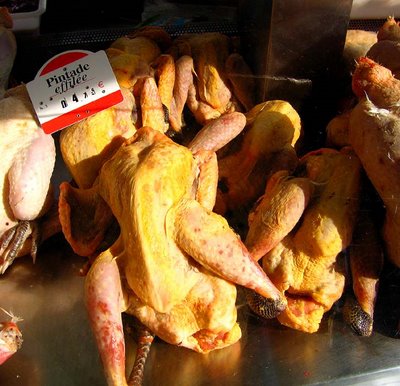
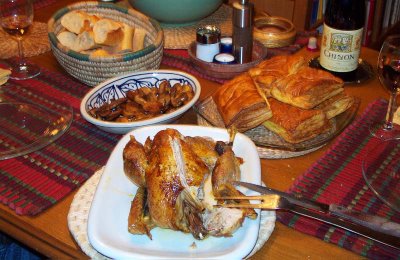 The side dishes are sautéed mushrooms, purchased from the mushroom lady at the market, who grows them and sells them, along with galettes de pommes de terre — puff pastries made by incorporating mashed potatoes into the pastry dough (made with flour and butter). To finish the meal, a good lettuce salad, some bread, and a bottle of Chinon wine. A feast.
The side dishes are sautéed mushrooms, purchased from the mushroom lady at the market, who grows them and sells them, along with galettes de pommes de terre — puff pastries made by incorporating mashed potatoes into the pastry dough (made with flour and butter). To finish the meal, a good lettuce salad, some bread, and a bottle of Chinon wine. A feast.
 The church towers in Saint-Aignan seen from the market square
The church towers in Saint-Aignan seen from the market square Here's a recent picture of Walt emerging from a bou-
Here's a recent picture of Walt emerging from a bou- This is the kind of thing that Chris called a "ghost sign."
This is the kind of thing that Chris called a "ghost sign."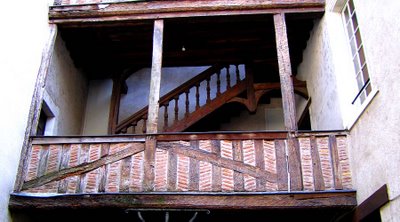 In the streets of old Blois, there are courtyards you can look into along the way. This one had a nice old staircase in it.
In the streets of old Blois, there are courtyards you can look into along the way. This one had a nice old staircase in it. At the famous château in Blois, there's this statue of an equestrian Louis XII (1452-1516). His reign ushered in the Renaissance. He was a popular figure and was known as "the father of his people."
At the famous château in Blois, there's this statue of an equestrian Louis XII (1452-1516). His reign ushered in the Renaissance. He was a popular figure and was known as "the father of his people."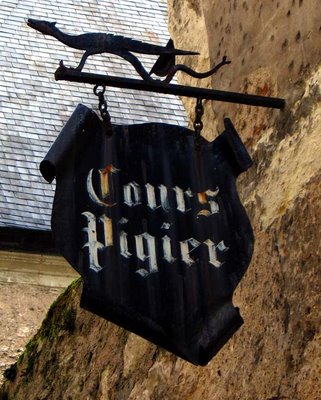 In old town Blois, the Pigier secretarial school occupies a fine old building and has a nice old sign.
In old town Blois, the Pigier secretarial school occupies a fine old building and has a nice old sign. At the Hôtel de Ville — city hall — there's a display of posters explaining the rights of children in France. This one lists the responsibilities of parents and the State.
At the Hôtel de Ville — city hall — there's a display of posters explaining the rights of children in France. This one lists the responsibilities of parents and the State. Looking down on the rooftops of Blois and the Loire river from the rose garden at the Hôtel de Ville.
Looking down on the rooftops of Blois and the Loire river from the rose garden at the Hôtel de Ville.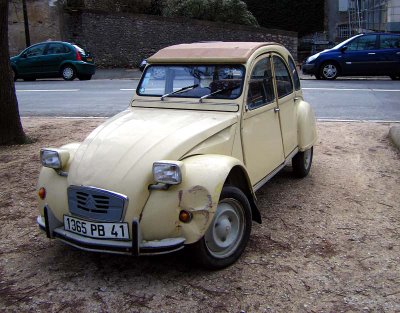 You still see quite a few of these old Citroën 2CV (Deux Chevaux) cars here in the Loire Valley. I think they stopped manufacturing them more than 20 years ago.
You still see quite a few of these old Citroën 2CV (Deux Chevaux) cars here in the Loire Valley. I think they stopped manufacturing them more than 20 years ago.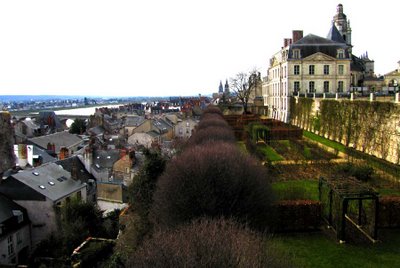 This is a picture of the rooftops of Blois, the rose garden, and the Hôtel de Ville. You can see the steeple of the cathedral on the right, the steeples of the Eglise St-Nicolas in the distance, and the Loire river on the left.
This is a picture of the rooftops of Blois, the rose garden, and the Hôtel de Ville. You can see the steeple of the cathedral on the right, the steeples of the Eglise St-Nicolas in the distance, and the Loire river on the left.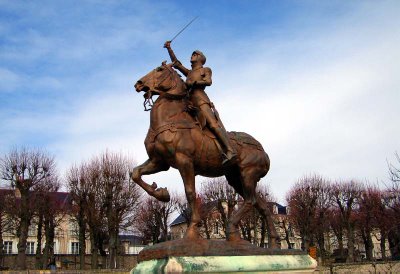 At the Hôtel de Ville there's this statue of Joan of Arc on horseback. It was donated by an American philanthropist and francophile.
At the Hôtel de Ville there's this statue of Joan of Arc on horseback. It was donated by an American philanthropist and francophile. Le château de Chaumont-sur-Loire, one of the most famous attractions
Le château de Chaumont-sur-Loire, one of the most famous attractions Le château de Valmer, near Vouvray, is a wine château
Le château de Valmer, near Vouvray, is a wine château The road into the Château de Quinçay wine house
The road into the Château de Quinçay wine house The Saint-
The Saint- Here's a picture of the main part of the château. It was built during the Renais-
Here's a picture of the main part of the château. It was built during the Renais- Standing on the château grounds — in the main courtyard — you overlook the rooftops of old Saint-
Standing on the château grounds — in the main courtyard — you overlook the rooftops of old Saint-
